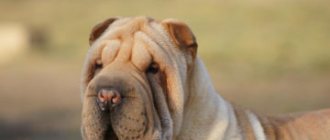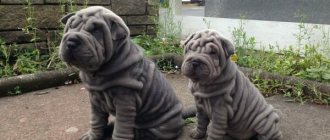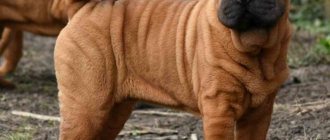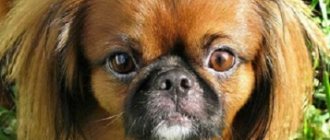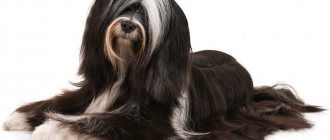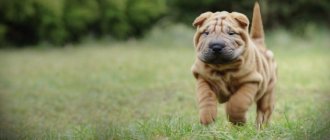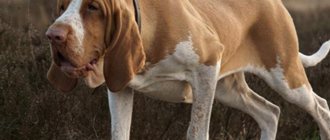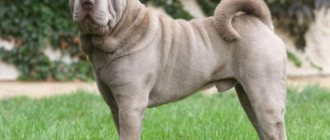Until a certain point, Shar Peis were a single Chinese breed.
Fighting, hunting, guard dogs. But in the mid-to-late 20th century there was a division into Chinese and American Shar-Peis. If you look at the standard, it turns out that the division is not officially recognized: absolutely all Shar Peis must fit the description of the breed. The appearance of Chinese and American dogs differs from each other and from the standard. Therefore, despite the dissatisfaction of experts, judges of major international exhibitions make concessions to Shar Pei owners and turn a blind eye to slight discrepancies with the official description.
To avoid problems and maintain fairness in the competition, the judges developed an algorithm for choosing the best Shar Pei:
- all participating dogs are divided into two groups: Chinese and American type;
- One dog is selected from each group that best meets the standard;
- the winner is determined by comparing the two group leaders.
Chinese Shar Peis become champions more often than American ones - due to their greater compliance with standards.
Description of the breed
The Chinese Shar Pei is a medium-sized dog with a strong build, covered with folds of varying depths. Breeders from the Middle Kingdom, unlike their American colleagues, recognize only individuals with the shortest type of coat - horse. The length of the hairs on the animal’s body cannot exceed 1 centimeter.
To understand how the “Chinese” differ from the “Americans”, comparison is indispensable. The main differences are:
- the Chinese type is more squat and stocky, in females the body is more elongated;
- this type has more folds, both on the head and on the body, thanks to them, Chinese Shar-Peis look plump;
- the nose of the “Chinese” is larger and more massive, the muzzle is not as toned as that of the “Americans”;
- Black and monochrome colors are not found among traditional Chinese Shar-Peis.
History of appearance
This breed was bred for dog fighting, a popular entertainment among the common people of Ancient China from the 3rd-2nd century BC. Features that helped dogs in fights developed and were cultivated: folds and short, spiky hair for protection, powerful jaws and paws for attack.
Over time, representatives of the breed spread widely throughout the territory of the Celestial Empire and mastered new functions for themselves - protecting property, protecting the owner and hunting large animals. Shar Peis were ideal for performing these tasks.
For some unknown reason, the breeding books of Chinese Shar-Peis were destroyed by order of one of the rulers of the Celestial Empire. Because of this, much of the breed's history is based on logical calculations and assumptions.
But the date when Chinese Shar-Peis could disappear completely is clearly defined - 1949. It was at this time that the communists, who came to power in China, decided that any pets were a legacy of the hated regime. Huge taxes were imposed on the maintenance of animals, and often the unfortunate four-legged friends were simply destroyed, without regard to thoroughbredness or historical value.
After a few years, Shar Peis remained only in remote rural farms, where the owners carefully hid them from the authorities.
In 1965, a Chinese Shar-Pei puppy, Lucky, arrived in the United States, and it was he who became the impetus for the emergence of American Shar-Peis, but that is a completely different story.
After the end of the terror declared on four-legged friends, war began in communist China. The fact that after its end the old-type Chinese Shar-Peis still existed can only be described as a miracle.
In 1976, the breed standard was approved, and 9 years later, Shar Peis were recognized by the American Kennel Club. In our country, dogs of this breed appeared only in the 1990s.
Coat types
Regardless of color, Shar Pei fur is divided into three types:
- horse - up to 1.5 centimeters;
- brush – from 1 to 2.5 centimeters;
- bear - longer than 2.5 centimeters.
Experts also identify additional nuances: short brush, long brush, half brush, but this division is not officially recognized and is used mainly to accurately describe the dog in conversations between dog handlers.
Horse
During puppyhood, Horse Shar-Peis acquire a huge number of folds. These are the kids who are featured on posters and promotional materials. With age, the folds smooth out and the dog acquires an athletic build. Horse Shar-Peis are usually fitter and slimmer than their counterparts.
The official name is horsecoat. The Shar Pei Horse is the only species recognized as purebred in China. Hair length is up to 1.5 centimeters.
Among the features inherent in such dogs, it is worth noting their low tolerance to frost - due to their short hair, they freeze more and faster, and they do not develop an undercoat.
Shar Peis with this coat type have faster nail growth, which requires frequent grooming.
People with sensitive skin may experience irritation when coming into contact with the short and coarse hair of a Shar Pei, which, however, quickly disappears.
This type of coat becomes greasy faster, and the dog requires water treatments more often.
Brush
Puppies have fewer folds than the Horse type, but as they grow older they do not smooth out, and adult Brushes have more folds than the Horse type.
The official name is brushcoat. Despite the disagreement of Chinese breeders, this type is officially recognized by international canine associations. There are no restrictions on participation in events. Length – from 1 to 2.5 centimeters.
Longer hair makes brush-type Shar-Peis look massive and stocky, although this is not true: Horses of the same size weigh more.
During the cold season, Brushes acquire a thick undercoat, which helps them feel comfortable in sub-zero temperatures. They shed quite actively.
Bear
The official name is bearcoat (“bear coat”). Long-haired Bear Shar-Peis are not allowed in show-class exhibitions, but participate in other shows without any problems. Length - more than 2.5 centimeters.
This coat appears in puppies if both parents are carriers of the recessive bear hair gene. This gene was already present in dogs exported from China in the 1970s.
The fluffy Shar-Pei bear-like appearance is very reminiscent of the Chow Chow. They are stocky, heavy, with a large head. Folds are present, but they are not visible behind the long hair.
Puppies look like fluff balls, and the soft coat continues into adult dogs. Representatives of this type are calm, affectionate animals, prone to phlegmatism.
Breed standard
- Height at withers : males - up to 51 centimeters, females - from 40 centimeters.
- Weight : ranging from 18 to 25 kilograms.
- Lifespan : from 10 to 12 years.
- Coat : short - up to 1 centimeter, without undercoat, hard, not adjacent to the skin.
- Color : red, black, fawn, blue, lilac, red, isabella, chocolate, coffee, sable, fawn.
- Head : proportional, large, with folds.
- Ears : small, thick, triangular, rounded tips, curved forward.
- Eyes : small, almond-shaped, sunken.
- Neck : medium size, developed.
- Back : arching behind the withers and rising towards the loin, short, wide, powerful.
- Chest : Quite deep and wide.
- Tail : Tapers towards the tip, thick at the base. It twists into a ring or bends over the back without touching it.
- Forelegs : with developed, sloping, laid back shoulders. Direct. The elbows are located close to the body. Powerful and flexible. The paws are medium in size and strong.
- Hindquarters : Well muscled and moderately angulated. The short hock joints are perpendicular to the ground.
Price range
The cost of a puppy starts from 35 thousand rubles. It depends on the location of the nursery, the titles of the parents, the gender of the puppy, its color, age and other characteristics.
According to an advertisement or on the market, you can buy a puppy for 5-15 thousand rubles, but in this case there is no guarantee that the puppy is healthy and meets the breed standard.
Appearance Features
The appearance of the Chinese Shar Pei makes one think of plush toy dogs.
The many folds throughout the body cause tenderness. A frown, caused by folds in the eyes, adds additional zest to the image of a Shar Pei. The coat is rough and short, but nevertheless quite dense and feels like plush to the touch.
A feature inherent in the breed is a blue-black oral cavity. Lips, tongue, palate - such an unusual color for dogs. A similar color is found only in the Chow Chow.
Thick paws with folds add massiveness and “tower-like” appearance to the dog.
The tail does not straighten completely - the characteristic “pretzel” completes the image of the “plush” dog.
There are no white Shar Peis.
The uniform color can be lighter on the tail and under it, darker on the muzzle and spine.
Photos with examples of colors
There is a classification of Shar Peis according to the color of their coat.
The main color suggests the presence of a black mask and “belt”. The coat can be black, cream, fawn, red fawn, isabella, red, blue (including all shades of grey) and sable.
The group of dilute colors includes cream, apricot, red, chocolate, lilac, and isabella colors. The main difference from the main colors is the complete absence of black on the pet’s coat.
Unusual colors include spotted (spots of red, blue or chocolate on a white coat) and saddleback (the back is covered with black fur with light tan).
NOTE!
Solid white coat color is unacceptable - such dogs have many hereditary pathologies.
Character, intelligence and behavior
A serious appearance and “frowning” can be misleading: at home, Shar Peis are the kindest dogs, loving and appreciating care and affection.
The owner is the most important thing in life.
Representatives of the breed will adapt to the mood, activities, and lifestyle of the owner. They are ready to do anything if only the owner is nearby: it doesn’t matter where - on a noisy street, in a quiet park, at home in front of the TV.
But in order for the Shar Pei to be recognized as a leader, you will have to work hard: these dogs themselves are not averse to dominating. If the owner does not insist on following commands and indulges the pet’s whims, a role change is possible, and the animal will feel like a leader.
Shar Peis are suspicious and wary of strangers. Aggressive towards foreign animals. They consider dogs as competitors, others as prey.
How children get along with a Shar Pei is a difficult question. If you already had a child when the pet came into the family, no problems are expected. But the dog perceives the appearance of a new family member with bewilderment. Older children will find in a dog of this breed a true friend, ready to share games and entertainment, and take on protection.
Calmness and friendliness are character traits that make the “Chinese” an excellent companion who can live in an apartment without any problems. But Chinese Shar-Peis are not suitable for kennel keeping - this both harms their psyche and threatens their health: short hair does not allow them to stay outside for a long time in the domestic climate.
Content
The Shar Pei is only suitable for living in an apartment or private house, and is absolutely not suitable for outdoor living. This is a companion dog that should always and everywhere be close to a person. You can often hear owners complain that Shar Pei smell strongly. The skin of healthy dogs has a slight sweetish odor, but if the dog is poorly cared for or has health problems, especially dermatological ones, it may not emit the most pleasant aroma. Shar Peis have a very hard coat, so hairs that fall out on the carpet or upholstered furniture often get stuck and prickly.
Shar Peis do not like to be stroked between the ears or on the back, or when approached from behind. This is most likely due to the dog's limited lateral vision due to the folds. For the same reason, Shar Peis do not always have good relationships with children. It is difficult to explain to a child how to approach and pet a puppy correctly without causing him stress or fear, which could develop into aggression in the future.
Exercise stress
Moderate physical activity is needed. Short walks and games near the house or in the park are quite enough for Shar Pei. But there are also very active specimens that will gladly keep company on a morning jog. It is worth noting that in hot weather, dogs are prone to overheating, and with the onset of cold weather, clothing appropriate for the weather will be relevant: overalls, sweaters, boots and hats. Some Shar Peis refuse to go out for walks in the cold, some are even allergic to the cold, so walks in winter should be reduced to a minimum.
Training and education
Chinese Shar-Peis require early socialization. Without it, the pet will show aggression towards passers-by and other animals.
Natural distrust will be an excellent basis for developing security skills. Shar Peis are generalists, capable of combining the duties of a guard and watchman, and at the same time being a devoted friend.
These dogs learn commands well and are easy to train. But you shouldn’t relax - the Shar Pei will definitely try to find the boundaries of what is permitted and step over them.
The main thing in raising such dogs is to immediately make it clear who is in charge, and constantly maintain the title of leader, setting clear rules of behavior that the pet can understand.
Features of feeding
Shar Pei food allergies require caution and careful introduction of new foods.
Premium dry food should be hypoallergenic, but balanced so that the pet’s body receives all the substances necessary for health.
If your dog consumes natural products, you need to carefully monitor the serving size: the constitution is conducive to weight gain, the animal cannot limit itself.
Be sure to exclude pork and chicken from your diet, limiting yourself to beef, lamb and turkey. You can diversify your diet with porridge in water or broth, vegetables, and fish.
What to feed Shar-Peis?
Proper nutrition is an important component of health and good mood. You can go two ways - choose ready-made dry food or natural food.
The main thing is not to mix. Decide: either natural feeding or industrial dry (wet) food from one company.
Never skimp on your dog! If you cannot provide your pet with quality food, it is better not to get one.
When feeding dry food:
- Follow the instructions on the food box.
- Keep an eye on the expiration date.
- Carefully switch to a new product, in small portions, preferably within a week.
When feeding natural food:
- Fresh food at room temperature.
- Teach your Shar Pei puppy to eat from a stand, and only from a bowl. Subsequently, this will protect him from poisoning on the street.
- If your pet is underfed, put the food in the refrigerator, and next time reduce the portion;
- After eating, wipe any remaining food from the face with a damp cloth, paying special attention to the lips and dewlap.
Forbidden:
- Smoked products
- Pasta
- Sweets
- Chocolate
- Bird with small tubular bones
- Fatty pork
- Legumes
- Cabbage
- Potato
- Eggs
- Hard cheese
Healthy:
- Rice
- Buckwheat
- Lean beef, if it does not cause allergies
- Mutton
- Rabbit meat
- By-products (no more than 40% of the daily meat allowance)
- Poultry meat
- Sea fish, but with great care
At one meal, you can give cereal with raw or boiled meat, taking into account the meat norm - 15 grams. by 1 kg per day. The broth from the broth is harmful to Shar Pei.
You can add zucchini, pumpkin, cauliflower or broccoli to the porridge.
Grated raw vegetables can be given with the addition of vegetable oil.
Vegetable oil is very useful for Shar Pei; in winter it can be added to any dishes, one teaspoon at a time. This will make the coat shiny and prevent cracks in the paw pads.
Please note that no owner will be able to correctly calculate the content of nutrients, microelements and other things. Therefore, when it comes to natural nutrition, it is necessary to include complex vitamins in the diet. Take in courses according to the instructions.
It is not recommended to give Shar Pei, as he is allergic, a variety of dried bones, dried tails and ears. They lead to eye skin problems.
Advantages and disadvantages
A long, complex history could not but affect the character of the Chinese Shar-Pei. Before adopting a puppy of this breed, you need to carefully consider the positive and negative traits inherent in the pet.
pros
- A big advantage is the adaptability of Chinese Shar-Peis to apartment living - not many medium-sized dogs feel comfortable in a limited space.
- Unusual appearance is another plus in the piggy bank. The “Chinese” will not remain without the attention of others.
- Friendliness, calm disposition, strong nervous system and commitment to cleanliness make Chinese Shar Peis excellent companions.
- Such dogs are always ready to protect both the owner and his property.
- Easy care and the absence of a characteristic “dog” smell further increase the attractiveness of the breed.
Minuses
- Allergic reactions to food and diseases inherent in the breed require increased attention from the owner to the health of the pet.
- The Shar Pei's attempts to try on the role of a leader will make the owner's life interesting, but difficult.
- Long walks are a joy if you have time, but if not, then your Shar Pei still needs them.
- A complex character will be a problem for a novice dog breeder: if there is no desire to overcome difficulties, it is better to take a dog of a different breed.
Tips for choosing a puppy
Buying a puppy is always an exciting and exciting process. The future owner admires the folded lumps and his composure falls asleep. Emotions force a person to act hastily and thoughtlessly, because what could be more important than bringing a cute baby home.
Please note that choosing a Shar Pei puppy is a huge responsibility, complicated by a wide range of risks. If you are not familiar with the breed, be sure to seek help from experienced owners and study the maximum amount of theoretical data. Under no circumstances agree to buy a puppy without a pedigree (even if the baby has no prospects in a show career). Don't save money at the selection stage and look for a breeder who is literally obsessed with the health of their dogs!
An undocumented dog also needs love and care, but by purchasing such a puppy, you are consciously taking a risk. If you are ready to fight and give maximum attention to your pet, contact specialized shelters for abandoned Shar-Peis (unfortunately, there are quite a few of them).
The only thing that should interest you is the documents of the parents and the reports of veterinary examinations. Imported males are not near the puppies and you can judge their health only by papers. The entire litter must be examined by a veterinarian and a breed expert, have the appropriate conclusions and a puppy pedigree.
Important! Be sure to watch the puppies eat! Shar Peis are prone to idiopathic enlargement of the esophagus (megaesophagus). The disease can be detected during examination by a veterinarian; symptoms include: excessive drooling, difficulty swallowing. Stunted growth may also indicate pathology, since food is retained in the esophagus and then either “sinks” into the stomach or causes vomiting.
Having decided on your favorite, discuss with the breeder the possibility of additional examination by “your” veterinarian. A sharply negative reaction should alert you. Try to be as open-minded as possible about the purchasing process! Request a purchase and sale agreement, ask for several meetings before purchasing, weigh your desires and emotions. The only thing that should interest you is the dog’s health and heredity.
Important! If you want to work with a pet at shows, it is better to immediately contact large nurseries with an excellent reputation, since buying a puppy from someone else will not lead to anything good!
How to properly care
- Brushing no more than three times a week - with a short hair brush. Chinese Shar-Peis do not shed and do not have an undercoat. Caring for a centimeter coat will not cause problems.
- Bathing - depending on how dirty it is, at least once every 4 months. Wash products are only hypoallergenic, so as not to harm the skin. After water treatments, dry with a hairdryer, paying special attention to folds.
- Ears need to be cleared of wax several times a week. A cotton swab and lotion will help with this procedure. It is better to pluck the hair growing in the ears to ensure free access of air.
- The claws must be trimmed every month, using a special nail clipper, if they do not get worn down during walks. Trim carefully so as not to touch the vessels.
- your eyes every morning with water or chamomile decoction to remove dirt and discharge.
- your teeth regularly to prevent plaque.
Life expectancy and major diseases
Quite complex genetics have led to a whole list of diseases to which the breed is predisposed:
- amyloidosis;
- panostitis;
- bite problems;
- otitis;
- vision problems;
- dysplasia of the knee and pelvis;
- dislocations of the knee joints;
- osteodystrophy, osteochondrosis;
- swollen joints;
- a whole range of allergic reactions;
- tendency to neoplasms – both benign and malignant.
With careful care and proper maintenance, Chinese Shar-Peis live from 10 to 12 years.
